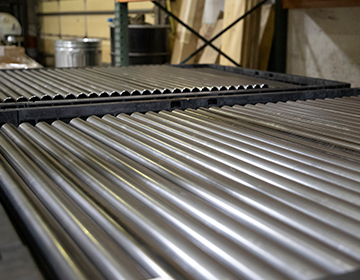Wooley's tube cutting process involves the precision cutting of metal tubes to achieve specific lengths or shapes.
This step is fundamental in creating tubes of the required dimensions for various applications across industries such as construction, automotive, HVAC (heating, ventilation, and air conditioning), and more.
As with other tube manufacturing processes, the first step involves selecting the appropriate material for the tubes based on the application requirements. Common materials include steel, aluminum, stainless steel, and copper.
Tubes are prepared by ensuring they are straight, and the ends are clean and free from any imperfections. Proper preparation is essential for accurate cutting and to avoid damage to cutting tools.

Tube cutting machines come in various types, including saws, lasers, plasma cutters, and water jets. The choice of cutting machine depends on the material, thickness, and precision requirements. The machine is set up by selecting the appropriate cutting method, adjusting parameters, and ensuring alignment for accurate cuts.
Saw Cutting: Uses a rotating blade to make straight cuts. Suitable for a wide range of materials and thicknesses.
Laser Cutting: Utilizes a laser beam to make precise cuts. Ideal for intricate shapes and high precision.
Plasma Cutting: Involves using a plasma torch to cut through metal. Suitable for thicker materials.
Water Jet Cutting: Employs a high-pressure stream of water mixed with abrasive particles to cut through materials. Suitable for a variety of materials, including sensitive ones.
The tube is securely clamped in the cutting machine, and the cutting tool is applied to make the required cuts. The machine ensures that the cuts are straight, precise, and meet the specified dimensions.
Modern tube cutting machines often feature automation and CNC (computer numerical control) technology. This allows for high repeatability, accuracy, and the ability to handle complex cutting patterns.
Quality control measures are implemented throughout the cutting process to ensure that the tubes meet dimensional specifications. Inspections may include checking for cut accuracy, squareness, and the absence of burrs.
After cutting, tubes may undergo deburring to remove any sharp edges or burrs. Cleaning processes may also be applied to ensure the cut tubes meet cleanliness standards.
Depending on the application, additional operations such as end forming, bending, or welding may follow the cutting process to further shape or prepare the tubes.
Once the tubes are cut to the desired lengths or shapes, they are packaged and prepared for shipping to the end-user or subsequent manufacturing stages.
Wooley's tube cutting process is a critical step in tube manufacturing, ensuring that tubes are accurately shaped and dimensioned according to the specific requirements of diverse industries. When you're ready to get to work, get in touch. We Just Work!
